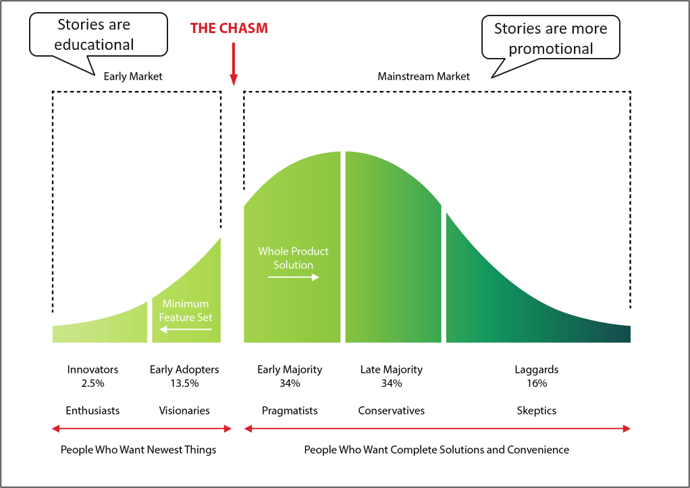I am always talking about how to drive momentum because momentum drives revenue. In this post, momentum doesn't mean lead generation. Of course, leads are important, but lead generation will be hard without brand momentum. It is a rare organization that increases market share without creating brand momentum. Today, we focus on a critical foundational element, The Communications Flywheel, a subset of the Marketing Flywheel, to drive brand momentum, particularly for emerging technology.
How Do Emerging Tech Companies Communicate Differently?
In Geoffrey Moore's famous book, Crossing the Chasm, he shares proven frameworks and strategies to bring new, cutting-edge products to market successfully,
His Technology Adoption Life Cycle model explains how new products are accepted. Generally, technology adoption follows a bell curve, with five distinct consumer groups differentiated by their attitudes to new technology:
- Innovators (tech enthusiasts)are passionate about new technology.
- Early adopters (visionaries)embrace new technologies to achieve a broader vision and are good at explaining the potential benefits to others.
- The early majority (pragmatists)are more cautious and realistic. They're only willing to adopt technology that's proven and convenient.
- The late majority (conservatives)are uncomfortable with new technology. They'll adopt it only when most people are already using it.
- Laggards (skeptics)don't want to be associated with new technology and may unknowingly use it.

Companies market and communicate depending on where their technology sits in the Technology Adoption Life Cycle. Suppose the technology has not crossed the chasm. In that case, marketing and communications programs need to educate prospects on the problem the technology solves and how it all works.
If the technology is already in the mainstream market, people already know they have a problem, and there are several viable solutions to solve that problem. The message is typically focused on why the prospect should choose your solution, and it tends to be more promotional.
If you lead with a promotional message in an early market, your company will likely not be viewed as credible.
Let's get back to the flywheel.
What is a Flywheel?
A flywheel is a mechanical device and refers to a very heavy wheel used to generate and transfer power to other parts of a machine. The flywheel requires significant force to start spinning but begins to turn itself and generate its own momentum once spinning.
Jim Collins originally coined "the flywheel effect" in the book Good to Great as a strategic business strategy. According to Collins, "there's no single killer innovation, no solitary lucky break, no miracle moment; rather, the process resembles relentlessly pushing a giant, heavy flywheel, turn upon turn, building momentum until a point of breakthrough and beyond."
In our most-read post of all time - The Number One Reason Why You Need a Marketing Flywheel, we talk about how Amazon leveraged the flywheel and how it was critical to its success. Hubspot also uses a flywheel strategy to explain the momentum you gain when you align your entire organization around delivering a remarkable customer experience. With the Hubspot flywheel, the momentum of your happy customers drives referrals and repeat sales, and your business keeps growing.
The Communications Flywheel
We use the flywheel model and apply it to how you need to communicate your brand to the market. It is used to generate brand momentum, not lead generation. Positive brand momentum will generate interest in your company, and leads will follow.
Emerging tech companies in early markets need to get this wheel spinning. It is critical to their success. Here are the topics a firm must talk about in the market to get the flywheel spinning.

Spokes of the Flywheel
Each spoke of the flywheel is important to demonstrate that your technology and company are viable for the long term.
- Vision: Tech companies need to articulate a long-term vision. This helps prospects evaluate the viability of the technology and the company. (i.e., even early adopters want to invest in a dud)
- Ecosystem: Ecosystems are very important for technology companies. Technology does not stand alone; it needs to work seamlessly with other technologies. Participating in an ecosystem, driving standards, and partnering for integration demonstrates industry leadership.
- Business Validation: Revenue is dependent on business cases, not vision. Consistently prove business value with concrete business cases. Prove it works and that it adds value to the bottom line.
- Customer Validation: Demonstrate how customers are using your product and services. IS the solution real if you don't have customers?
- Business Momentum: Announce major milestones, new products, new customers, and services. Submit and win awards. People want to buy from winners.
Effectiveness of the Flywheel
Several factors can impact the effectiveness of the communications flywheel.
- Strategic vs. Tactical: Communications need to be considered a strategic tool at the executive levels, not a tactical afterthought. For every strategic initiative, there should be a communications plan.
- Consistency – A consistent drumbeat of information is critical for working the flywheel. Start and stop programs don't work.
- Timing – Timing is important. Delivering the right information at the right time is critical.
Getting your communications flywheel spinning is a process, not a singular event. IF you need help, sign up for our consultation below. It is free with no obligation.




